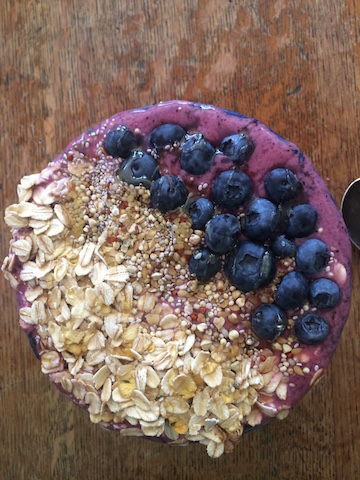Sugar overwhelms benefits of açaí berries
Popular fruit may not be so berry good

September 23, 2016
Teens are increasingly gravitating towards açaí bowls, an array of fruits, berries and grains arranged atop a base of blended, smoothie-like açaí berry, almond milk and banana as an attractive, healthy meal alternative.
So-called superfoods like açaí, salmon, broccoli or blueberries tend to be rich in antioxidants, fiber and fatty acids are considered beneficial because they augment energy and regulate cholesterol, according to Weil Lifestyle.
“Superfoods are generally not native and so they are imported,” physician researcher Jay Udani M.D., who researched the effects of concentrated açaí supplements in a small open-label pilot study, said.
The açaí berry, often praised for its supposed superfood benefits, is native to Brazil, and most commonly found in açaí bowls at establishments like Bare Bowls, Earth Bar, Basik Cafe and Bebebar.
“The closer you get to the original source of the food, the healthier it is,” Udani said. “That’s true of any fruit or vegetable, and it’s true of these so-called superfoods. The more processed they are, the more additives there are, the more sugar there is, the less healthy the fruit is overall.”
While most açaí bowls and the cafes that make them do not tend to use artificial sugar additives, rather natural sweeteners like agave, the concentration of sugars found in the fruit-based content can overwhelm the potential benefits of the açaí berry itself, according to Functional Medicine Nutritionist Shanti Pappas of Happy Belly Health.
“There are a lot of other ways to incorporate nutrients into your diet aside from sugar packed açaí bowls,” Pappas said. “The quantity of fruit in one of those açaí bowls is insane, it’s so much even in the fruit smoothies and things like that it’s a lot more than what we can process easily.”
Fresh seasonal fruits are more beneficial to eating habits and daily eating schedules, as opposed to the frozen ones used in açaí bowls, according to Pappas.
Açaí bowls typically consist of the açaí berry blended into a thick, creamy substance which, like frozen yogurt, gets topped with an assortment of fruits, nuts and seeds.
Some açaí bowls allow consumers to ingest all the suggested fruit servings in a day, as well as the suggested daily amount of protein, according to the United States Department of Agriculture.
Consumers must question how much of the berry’s nutritional value is maintained and be aware of additives, according to Udani.
“If you can get straight fruit or juice that’s ideal,” Udani said. “If it’s mixed with other things, you have to look at what percentage of the thing you’re eating is actually made from the fruit that you’re trying to consume.”
Udani’s research presented significant improvements in the bodies of his study subjects in their insulin and sugar levels, leading him to believe that açaí in high concentrations and consumed regularly could reduce levels of insulin and regulate blood glucose levels.
“One of the challenges with many of the superfoods or any natural drug product is that these benefits which are seen in clinical studies require extremely high doses of the product,” Udani said. “It is very unlikely that the type of results seen in our study could be replicated by somebody eating an açaí fruit every now and then because this study was people taking a high concentration of this product every single day for thirty days.”
Consumers should consider whether an açaí bowl is beneficial to the body and useful to one’s diet as opposed to simpler dishes, according to Pappas.
“We’re designed to enjoy lots of savory foods and then once in awhile have some fruit,” Pappas said of the fruit and berry density in the bowls. “Especially in the summer months when the days are longer and there’s more abundance in fruits. Looking to nature and looking to our environment can be a really good clue.”
Despite their drawbacks, Udani does not discourage high school students selecting the acai bowls as snacks to get them through the day.
“If you were to be making a choice between, for example, a candy bar and an açaí-containing beverage, supplement or bowl, that you’re better off with the açaí-containing product, assuming that the sugar level in that product is less than the sugar level in the candy bar,” Udani said.
Pappas recommends choosing the fruits from at local farmer’s markets to get fresh sources of antioxidants.
“Fresh fruit or berries have plenty of antioxidants, probably not the same concentration as açaí but it doesn’t have all that sugar impact,” Pappas said. “To be a high school student you need to be able to stay focused and pay attention in class. When you consume too much sugar from unhealthy sources, you’ll crash.”
The short preparing time it takes to make an açaí bowl and the amazing taste make the açaí bowls so appealing, according to junior Giulia Oltranti.
“I can understand the compulsion to want to eat an açaí bowl everyday because it’s sweet,” Pappas said. “The actual açaí is a very bitter fruit, it’s probably not even palatable when eaten raw and so they add a lot of honey and fruit to it.”
Aside from potential additives and other marketing claims, prices can also discourage customers from buying.
Oltranti began making açaí bowls at home after being more deterred by upwards of $8 açaí bowl than the products’ sugar-density.
“I wouldn’t recommend eating açaí bowls for every meal, but a few times a week is fine instead of like a smoothie,” Oltranti said. “You can use almond milk instead of dairy and it’s vegan so it feels pretty healthy.”
The nutritional value of the açaí bowl can depend on the kind of toppings and content of the bowl.
“I make fruit smoothies with protein powder in them,” Oltranti said. “I wouldn’t consider that unhealthy if there’s fruit with milk or Greek yogurt because there’s a lot of protein there, but if you’re putting a ton of chocolate chips in your smoothies and açaí bowls then that’s not really nutritious.”
Oltranti favors ingredients like bananas, frozen berries, almond milk, agave and her homemade granola, which she says feel like healthy ingredients.
“Açaí bowls have a texture in between ice cream and smoothies which are two of my other favorite things to eat,” Oltranti said. “They are quick to make and they taste amazing.”









